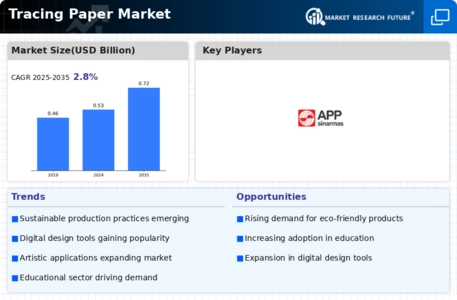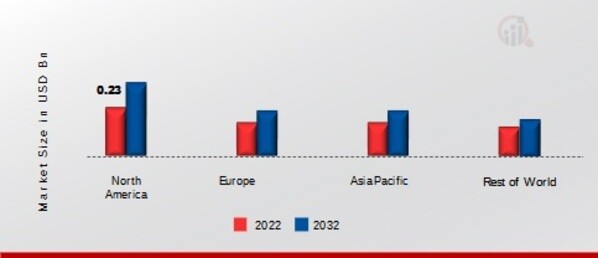-
EXECUTIVE SUMMARY
-
MARKET INTRODUCTION
-
Definition
-
Scope of the Study
- Research
- Assumptions
- Limitations
-
Objective
-
3.
-
RESEARCH METHODOLOGY
-
Overview
-
Data Mining
-
Secondary Research
-
Primary Research
- Primary
- Breakdown of Primary
-
Interviews and Information Gathering Process
-
Respondents
-
Forecasting Model
-
Market Size Estimation
- Bottom-Up Approach
- Top-Down Approach
-
3.7.
-
Data Triangulation
-
Validation
-
MARKET DYNAMICS
-
Overview
-
Drivers
-
Restraints
-
4.4.
-
Opportunities
-
MARKET FACTOR ANALYSIS
-
Value Chain Analysis
-
Porter’s Five Forces Analysis
- Bargaining Power
- Bargaining Power of Buyers
- Threat
- Threat of Substitutes
- Intensity
-
of Suppliers
-
of New Entrants
-
of Rivalry
-
COVID-19 Impact Analysis
- Market Impact
- Regional Impact
- Opportunity and Threat
-
Analysis
-
Analysis
-
GLOBAL TRACING PAPER MARKET, BY THICKNESS
-
6.1.
-
Overview
-
Up to 60 GSM
-
61 to 80 GSM
-
6.4.
-
to 100 GSM
-
Above 100 GSM
-
GLOBAL TRACING PAPER MARKET,
-
BY MATERIAL
-
Overview
-
Cellulose Fiber
-
7.3.
-
Cotton Fiber
-
Recycled Fiber
-
GLOBAL TRACING PAPER MARKET,
-
BY APPLICATION
-
Overview
-
Printing
-
8.3.
-
Drawing
-
Photographic & Cinema Lighting
-
Embossing
-
Lamination
-
Others (Greeting Cards, Envelopes, etc.)
-
GLOBAL TRACING PAPER MARKET, BY REGION
-
Overview
-
North America
- US
- Canada
- Germany
- France
- UK
- Italy
- Spain
- Rest of Europe
-
9.2.
-
Europe
-
Asia-Pacific
- China
- India
- Japan
- South Korea
- Australia
- Rest of Asia-Pacific
-
Rest of the World
- Africa
- Latin America
-
9.4.1.
-
Middle East
-
10.
-
COMPETITIVE LANDSCAPE
-
Overview
-
Competitive Analysis
-
Market Share Analysis
-
Major Growth Strategy in the
-
Global Tracing Paper Market,
-
Competitive Benchmarking
-
Leading Players in Terms of Number of Developments in the Global Tracing
-
Paper Market,
-
Key developments and Growth Strategies
- Merger & Acquisitions
- Joint Ventures
-
10.7.1.
-
New Product Launch/Service Deployment
-
Major Players Financial Matrix
- Sales & Operating Income, 2022
- Major Players
-
R&D Expenditure. 2022
-
COMPANY PROFILES
-
Koehler
- Company Overview
- Financial Overview
- Products Offered
- Key Developments
- Key Strategies
-
Paper Group
-
11.1.5.
-
SWOT Analysis
-
Domtar Corporation
- Company Overview
- Financial Overview
- Products Offered
- Key Developments
- Key Strategies
-
11.2.5.
-
SWOT Analysis
-
Mitsubishi HiTec
- Company Overview
- Financial
- Products Offered
- Key Developments
- SWOT Analysis
- Key Strategies
- Company Overview
- Products Offered
- Key Developments
- SWOT Analysis
- Key Strategies
- Company Overview
- Products Offered
- Key Developments
- SWOT Analysis
- Key Strategies
- Company Overview
- Products Offered
- Key Developments
- SWOT Analysis
- Key Strategies
- Company Overview
- Products Offered
- Key Developments
- SWOT Analysis
- Key Strategies
- Company Overview
- Financial Overview
- Products Offered
- SWOT Analysis
- Key Strategies
-
Paper Europe GmbH
-
Overview
-
11.4.
-
Asia Pulp & Paper Ltd
-
11.4.2.
-
Financial Overview
-
11.5.
-
PIXELLE SPECIALTY SOLUTIONS
-
11.5.2.
-
Financial Overview
-
11.6.
-
Nippon Paper Industries Co. Ltd
-
11.6.2.
-
Financial Overview
-
11.7.
-
Oji Papéis Especiais LTDA
-
11.7.2.
-
Financial Overview
-
11.8.
-
Papeles y Conversiones de México
-
11.8.4.
-
Key Developments
-
REFLEX GMBH & CO. KG
- Company Overview
- Financial Overview
- Products Offered
- SWOT Analysis
- Key Strategies
-
11.9.4.
-
Key Developments
-
Nekoosa Coated Products LLC
- Company Overview
- Financial Overview
- Products Offered
- Key Developments
- SWOT Analysis
-
11.10.6.
-
Key Strategies
-
APPENDIX
-
References
-
12.2.
-
Related Reports
-
-
LIST OF TABLES
-
GLOBAL
-
TRACING PAPER MARKET, SYNOPSIS, 2025-2034
-
GLOBAL TRACING PAPER
-
MARKET, ESTIMATES & FORECAST, 2025-2034 (USD BILLION)
-
GLOBAL
-
TRACING PAPER MARKET, BY THICKNESS, 2025-2034 (USD BILLION)
-
GLOBAL
-
TRACING PAPER MARKET, BY MATERIAL, 2025-2034 (USD BILLION)
-
GLOBAL
-
TRACING PAPER MARKET, BY APPLICATION, 2025-2034 (USD BILLION)
-
TABLE 6
-
NORTH AMERICA: TRACING PAPER MARKET, BY THICKNESS, 2025-2034 (USD BILLION)
-
NORTH AMERICA: TRACING PAPER MARKET, BY MATERIAL, 2025-2034 (USD BILLION)
-
NORTH AMERICA: TRACING PAPER MARKET, BY APPLICATION, 2025-2034 (USD
-
BILLION)
-
US: TRACING PAPER MARKET, BY THICKNESS, 2025-2034 (USD
-
BILLION)
-
US: TRACING PAPER MARKET, BY MATERIAL, 2025-2034 (USD
-
BILLION)
-
US: TRACING PAPER MARKET, BY APPLICATION, 2025-2034
-
(USD BILLION)
-
CANADA: TRACING PAPER MARKET, BY THICKNESS, 2025-2034
-
(USD BILLION)
-
CANADA: TRACING PAPER MARKET, BY MATERIAL, 2025-2034
-
(USD BILLION)
-
CANADA: TRACING PAPER MARKET, BY APPLICATION,
-
EUROPE: TRACING PAPER MARKET, BY THICKNESS,
-
EUROPE: TRACING PAPER MARKET, BY MATERIAL,
-
EUROPE: TRACING PAPER MARKET, BY APPLICATION,
-
GERMANY: TRACING PAPER MARKET, BY THICKNESS,
-
GERMANY: TRACING PAPER MARKET, BY MATERIAL,
-
GERMANY: TRACING PAPER MARKET, BY APPLICATION,
-
FRANCE: TRACING PAPER MARKET, BY THICKNESS,
-
FRANCE: TRACING PAPER MARKET, BY MATERIAL,
-
FRANCE: TRACING PAPER MARKET, BY APPLICATION,
-
ITALY: TRACING PAPER MARKET, BY THICKNESS,
-
ITALY: TRACING PAPER MARKET, BY MATERIAL,
-
ITALY: TRACING PAPER MARKET, BY APPLICATION,
-
SPAIN: TRACING PAPER MARKET, BY THICKNESS,
-
SPAIN: TRACING PAPER MARKET, BY MATERIAL,
-
SPAIN: TRACING PAPER MARKET, BY APPLICATION,
-
UK: TRACING PAPER MARKET, BY THICKNESS,
-
UK: TRACING PAPER MARKET, BY MATERIAL,
-
UK: TRACING PAPER MARKET, BY APPLICATION,
-
REST OF EUROPE: TRACING PAPER MARKET,
-
BY THICKNESS, 2025-2034 (USD BILLION)
-
REST OF EUROPE: TRACING
-
PAPER MARKET, BY MATERIAL, 2025-2034 (USD BILLION)
-
REST OF EUROPE:
-
TRACING PAPER MARKET, BY APPLICATION, 2025-2034 (USD BILLION)
-
TABLE 36
-
ASIA-PACIFIC: TRACING PAPER MARKET, BY THICKNESS, 2025-2034 (USD BILLION)
-
ASIA-PACIFIC: TRACING PAPER MARKET, BY MATERIAL, 2025-2034 (USD BILLION)
-
ASIA-PACIFIC: TRACING PAPER MARKET, BY APPLICATION, 2025-2034 (USD
-
BILLION)
-
JAPAN: TRACING PAPER MARKET, BY THICKNESS, 2025-2034
-
(USD BILLION)
-
JAPAN: TRACING PAPER MARKET, BY MATERIAL, 2025-2034
-
(USD BILLION)
-
JAPAN: TRACING PAPER MARKET, BY APPLICATION, 2025-2034
-
(USD BILLION)
-
CHINA: TRACING PAPER MARKET, BY THICKNESS, 2025-2034
-
(USD BILLION)
-
CHINA: TRACING PAPER MARKET, BY MATERIAL, 2025-2034
-
(USD BILLION)
-
CHINA: TRACING PAPER MARKET, BY APPLICATION, 2025-2034
-
(USD BILLION)
-
INDIA: TRACING PAPER MARKET, BY THICKNESS, 2025-2034
-
(USD BILLION)
-
INDIA: TRACING PAPER MARKET, BY MATERIAL, 2025-2034
-
(USD BILLION)
-
INDIA: TRACING PAPER MARKET, BY APPLICATION, 2025-2034
-
(USD BILLION)
-
AUSTRALIA: TRACING PAPER MARKET, BY THICKNESS,
-
AUSTRALIA: TRACING PAPER MARKET, BY
-
MATERIAL, 2025-2034 (USD BILLION)
-
AUSTRALIA: TRACING PAPER MARKET,
-
BY APPLICATION, 2025-2034 (USD BILLION)
-
SOUTH KOREA: TRACING
-
PAPER MARKET, BY THICKNESS, 2025-2034 (USD BILLION)
-
SOUTH KOREA:
-
TRACING PAPER MARKET, BY MATERIAL, 2025-2034 (USD BILLION)
-
SOUTH
-
KOREA: TRACING PAPER MARKET, BY APPLICATION, 2025-2034 (USD BILLION)
-
TABLE
-
REST OF ASIA-PACIFIC: TRACING PAPER MARKET, BY THICKNESS, 2025-2034 (USD BILLION)
-
REST OF ASIA-PACIFIC: TRACING PAPER MARKET, BY MATERIAL, 2025-2034
-
(USD BILLION)
-
REST OF ASIA-PACIFIC: TRACING PAPER MARKET, BY
-
APPLICATION, 2025-2034 (USD BILLION)
-
REST OF THE WORLD: TRACING
-
PAPER MARKET, BY THICKNESS, 2025-2034 (USD BILLION)
-
REST OF
-
THE WORLD: TRACING PAPER MARKET, BY MATERIAL, 2025-2034 (USD BILLION)
-
TABLE
-
REST OF THE WORLD: TRACING PAPER MARKET, BY APPLICATION, 2025-2034 (USD BILLION)
-
MIDDLE EAST: TRACING PAPER MARKET, BY THICKNESS, 2025-2034 (USD
-
BILLION)
-
MIDDLE EAST: TRACING PAPER MARKET, BY MATERIAL, 2025-2034
-
(USD BILLION)
-
MIDDLE EAST: TRACING PAPER MARKET, BY APPLICATION,
-
AFRICA: TRACING PAPER MARKET, BY THICKNESS,
-
AFRICA: TRACING PAPER MARKET, BY MATERIAL,
-
AFRICA: TRACING PAPER MARKET, BY APPLICATION,
-
LATIN AMERICA: TRACING PAPER MARKET,
-
BY THICKNESS, 2025-2034 (USD BILLION)
-
LATIN AMERICA: TRACING
-
PAPER MARKET, BY MATERIAL, 2025-2034 (USD BILLION)
-
LATIN AMERICA:
-
TRACING PAPER MARKET, BY APPLICATION, 2025-2034 (USD BILLION)
-
LIST OF
-
FIGURES
-
RESEARCH PROCESS
-
MARKET STRUCTURE
-
FOR THE GLOBAL TRACING PAPER MARKET
-
MARKET DYNAMICS FOR THE
-
GLOBAL TRACING PAPER MARKET
-
GLOBAL TRACING PAPER MARKET, SHARE
-
(%), BY THICKNESS, 2022
-
GLOBAL TRACING PAPER MARKET, SHARE (%),
-
BY MATERIAL, 2022
-
GLOBAL TRACING PAPER MARKET, SHARE (%), BY
-
APPLICATION, 2022
-
GLOBAL TRACING PAPER MARKET, SHARE (%), BY
-
REGION, 2022
-
NORTH AMERICA: TRACING PAPER MARKET, SHARE (%),
-
BY REGION, 2022
-
EUROPE: TRACING PAPER MARKET, SHARE (%), BY
-
REGION, 2022
-
ASIA-PACIFIC: TRACING PAPER MARKET, SHARE (%),
-
BY REGION, 2022
-
REST OF THE WORLD: TRACING PAPER MARKET, SHARE
-
(%), BY REGION, 2022
-
GLOBAL TRACING PAPER MARKET: COMPANY SHARE
-
ANALYSIS, 2022 (%)
-
KOEHLER PAPER GROUP: FINANCIAL OVERVIEW
-
SNAPSHOT
-
KOEHLER PAPER GROUP: SWOT ANALYSIS
-
FIGURE
-
DOMTAR CORPORATION: FINANCIAL OVERVIEW SNAPSHOT
-
DOMTAR CORPORATION:
-
SWOT ANALYSIS
-
MITSUBISHI HITEC PAPER EUROPE GMBH: FINANCIAL
-
OVERVIEW SNAPSHOT
-
MITSUBISHI HITEC PAPER EUROPE GMBH: SWOT
-
ANALYSIS
-
ASIA PULP & PAPER LTD: FINANCIAL OVERVIEW SNAPSHOT
-
ASIA PULP & PAPER LTD: SWOT ANALYSIS
-
FIGURE 21
-
PIXELLE SPECIALTY SOLUTIONS: FINANCIAL OVERVIEW SNAPSHOT
-
PIXELLE
-
SPECIALTY SOLUTIONS: SWOT ANALYSIS
-
NIPPON PAPER INDUSTRIES
-
CO. LTD.: FINANCIAL OVERVIEW SNAPSHOT
-
NIPPON PAPER INDUSTRIES
-
CO. LTD.: SWOT ANALYSIS
-
OJI PAPÉIS ESPECIAIS LTDA: FINANCIAL
-
OVERVIEW SNAPSHOT
-
OJI PAPÉIS ESPECIAIS LTDA: SWOT ANALYSIS
-
PAPELES Y CONVERSIONES DE MÉXICO: FINANCIAL OVERVIEW SNAPSHOT
-
PAPELES Y CONVERSIONES DE MÉXICO: SWOT ANALYSIS
-
REFLEX GMBH & CO. KG: FINANCIAL OVERVIEW SNAPSHOT
-
FIGURE
-
REFLEX GMBH & CO. KG: SWOT ANALYSIS
-
NEKOOSA COATED PRODUCTS
-
LLC: FINANCIAL OVERVIEW SNAPSHOT
-
NEKOOSA COATED PRODUCTS LLC:
-
SWOT ANALYSIS


 Source: Secondary Research, Primary Research, Market Research Future Database, and Analyst Review
Source: Secondary Research, Primary Research, Market Research Future Database, and Analyst Review

Leave a Comment